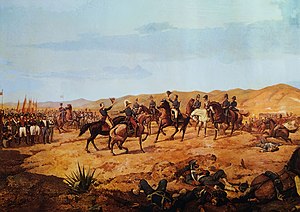This article includes a list of general references, but it lacks sufficient corresponding inline citations. (February 2019) |
The Peruvian War of Independence (Spanish: Guerra de Independencia del Perú) was a series of military conflicts in Peru from 1809 to 1826 that resulted in the country's independence from the Spanish Empire. Part of the broader Spanish American wars of independence, it led to the dissolution of the Spanish Viceroyalty of Peru.
Discontent in Peru increased during the 18th century Bourbon Reforms, which led to the 1780–1781 uprising by indigenous leader Túpac Amaru II. During the first decade of the 1800s Peru had been a stronghold for royalists, who fought those in favor of independence in Peru, Bolivia, Quito and Chile. The immediate backdrop to the Peruvian War of Independence was French Emperor Napoleon Bonaparte's 1807 invasion of Spain that forced King Charles IV and his son Ferdinand VII to abdicate in favour of Joseph Bonaparte, starting the Peninsular War. In Spanish America, autonomous governments arose in the power vacuum.
Viceroy José Fernando de Abascal y Sousa made Peru a base for counterrevolution and won military victories in the south frontier in 1809, in La Paz revolution and 1811 in the Battle of Guaqui. The first autonomous Peruvian rebellions arose in 1811 in the context of indigenous discontent and Creole collaboration with the May Revolution. The Peruvian insurgency put the interior of the country in rebellion, although the multiple uprisings of the Tacna, Huánuco, Huamanga, Cuzco, Apurimac and others did not achieve freedom for the country. However, the guerrilla and montoneras movements were maintained upon the arrival of the liberating forces.
In 1820, the Great Overseas Expedition rebellion made the threat of invasion in the Río de la Plata and Venezuela disappear and made the arrival of the liberating forces in Peru possible. The Liberating Expedition of Peru, under the command of Argentine General José de San Martín, landed on the Peruvian coast from Chile. The royalty abandoned Lima, fortified themselves in Cusco, and General San Martín proclaimed the independence of the Peruvian State on 28 July 1821. Under his Protectorate, the first Constituent Congress of the country was formed. With the stalemate of the conflict and the disappointing Guayaquil Conference with the Liberator Simón Bolívar, San Martín was forced to withdraw from Peru. The young republic was waging a war against the royalist strongholds in the interior of the country with an uncertain outcome. This situation led to the arrival of liberating forces from the north to Peru and of Simón Bolívar, who took over control of the United Liberation Army of Peru.
The fighting continued with the definitive defeat of the Spanish Army in 1824 in the battles of Junín and Ayacucho and culminating in 1826 with the Siege of Callao.[1] Consistent with the independence of Peru, in April 1825, the Sucre campaign in Upper Peru ended and, in November of that same year, the Spanish castle of San Juan de Ulúa in Veracruz surrendered to Mexico. Finally, in January 1826, the Spanish strongholds of Callao and Chiloé fell. Spain renounced all its American continental domains in 1836.
The results of Independence were varied: politically, dependence on Spain was cut off; economically, dependence on Europe was maintained; and socially, the removal of indigenous lands was accentuated in the republican era. Indigenous domestic workers were treated inhumanely, even in the first decades of the 20th century. They received citizenship at the birth of the republic, on 27 August 1821.[citation needed]
The struggle for independence in 18th and 19th century Peru was a complex and multifaceted process, marked by indigenous uprisings, colonial resistance, and the emergence of strong regional identities. Against the backdrop of Spanish colonial rule, women found themselves thrust into positions of leadership and responsibility within their households as husbands fled or were absent. This period of turmoil and change not only reshaped the socio-political landscape of Peru but also underscored the resilience and adaptability of its people, particularly women, in navigating the tumultuous path towards independence. By examining the intersecting narratives of colonial resistance, indigenous uprisings, and the evolving roles of women, we gain a deeper understanding of the dynamic forces at play in Peru's quest for autonomy and self-determination.[2]
In the 18th century, amidst early attempts for independence from Spanish colonial rule in Peru, women faced the challenge of assuming leadership roles within their households due to the absence or flight of their husbands. As indigenous uprisings and rebellions against colonial authority erupted, women found themselves navigating newfound autonomy and responsibilities, managing finances and familial affairs independently. Despite the unrest and discontent, exacerbated by Bourbon Reforms and the Rebellion of Túpac Amaru II, Peru remained strongly royalist during the Peninsular War, with the viceroy José Fernando de Abascal y Sousa suppressing uprisings and annexing Upper Peru to the viceroyalty. Ultimately, Peru's journey towards independence was marked by the campaigns of José de San Martín and Simón Bolívar.[3]
- ^ Cruz, Juan Luis Ossa Santa (2015). Armies, Politics and Revolution: Chile, 1808–1826. Oxford University Press. ISBN 978-1781387443.
- ^ Boutron, Camille; Constant, Chloé (September 2013). "Gendering Transnational Criminality: The Case of Women's Imprisonment in Peru". Signs: Journal of Women in Culture and Society. 39 (1): 177–195. doi:10.1086/670827. ISSN 0097-9740.
- ^ Boutron, Camille; Constant, Chloé (September 2013). "Gendering Transnational Criminality: The Case of Women's Imprisonment in Peru". Signs: Journal of Women in Culture and Society. 39 (1): 177–195. doi:10.1086/670827. ISSN 0097-9740.
